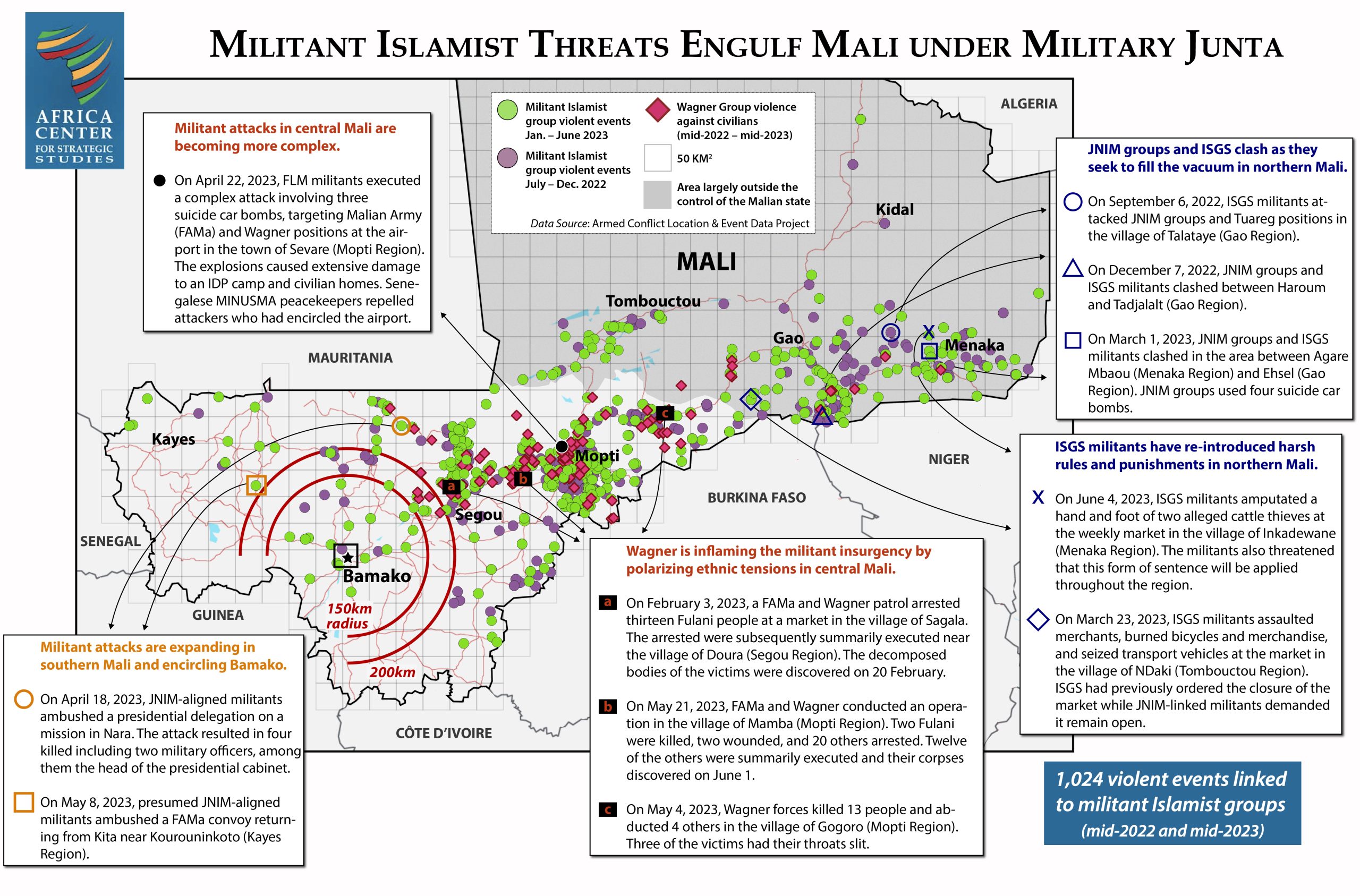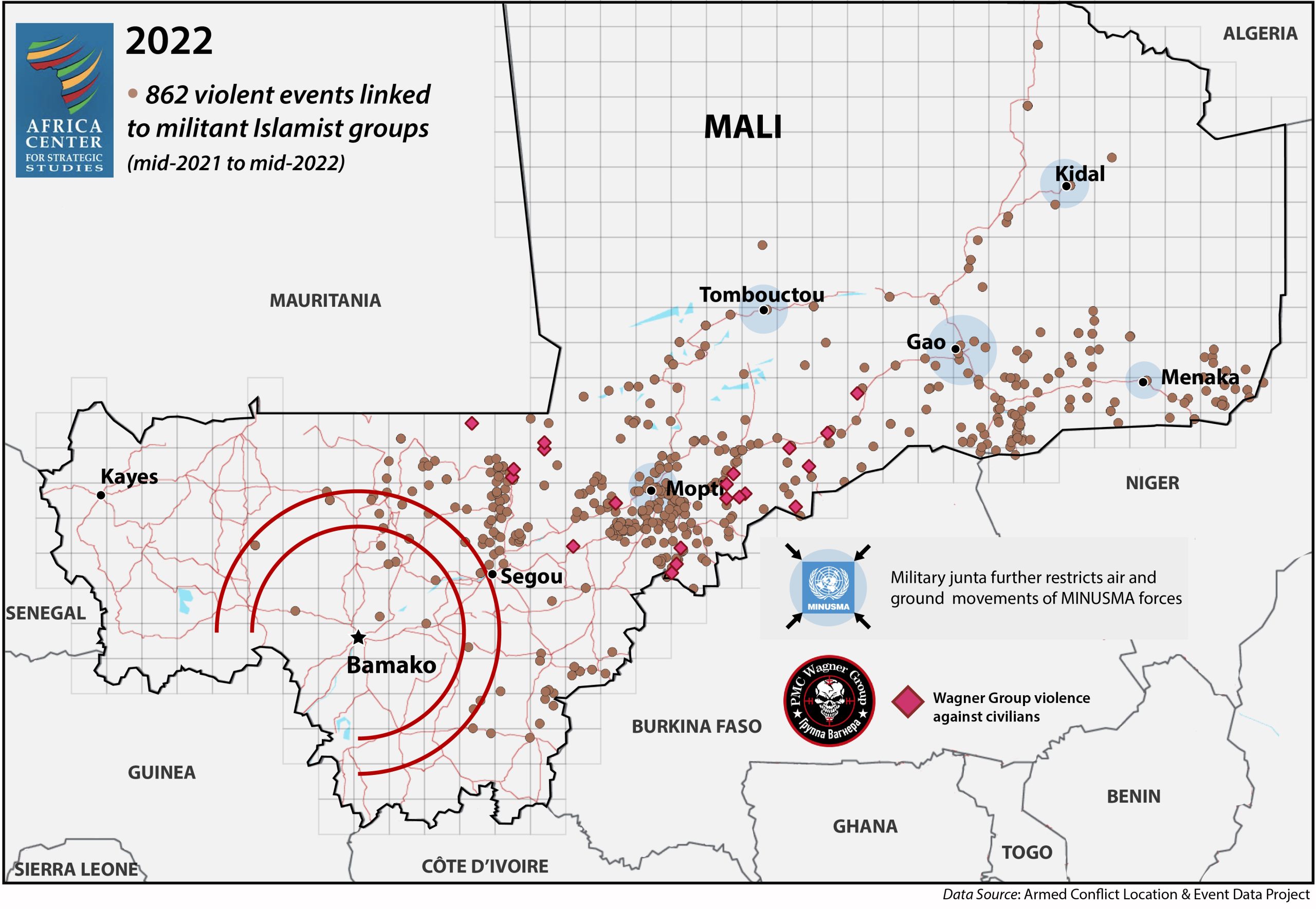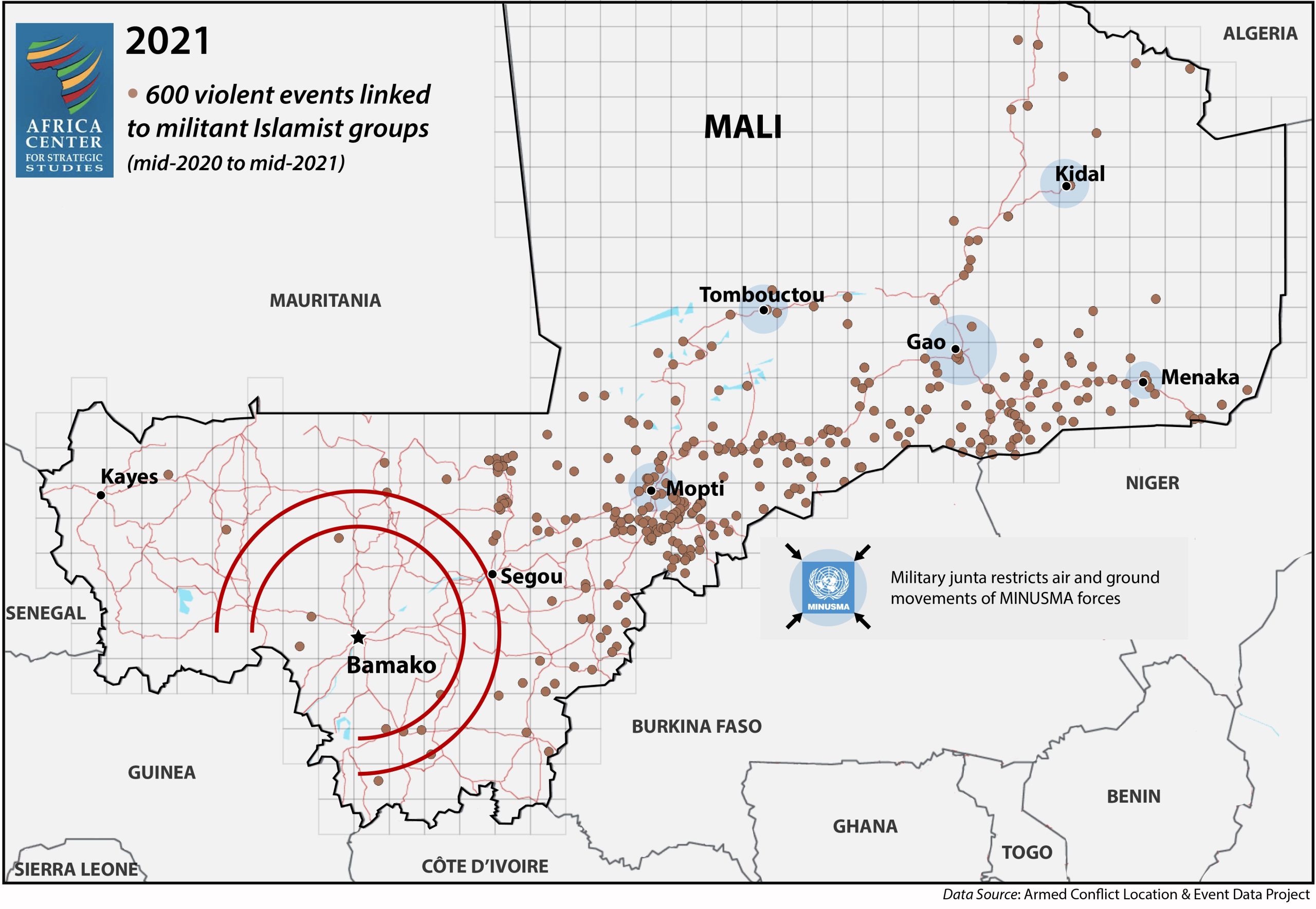Click here for a printable PDF version
A Spiraling Security Trajectory
The threat from militant Islamist groups in Mali continues to escalate in tempo and scale. With the military junta’s continued exclusion of other domestic political actors and alienation of regional and international security partners, the prospect of Mali’s collapse grows increasingly likely.
“Mali is on pace to see over 1,000 violent events involving militant Islamist groups in 2023, eclipsing last year’s record levels of violence and a nearly three-fold increase from when the junta seized power in 2020.”
- Mali is on pace to see over 1,000 violent events involving militant Islamist groups in 2023, eclipsing last year’s record levels of violence and a nearly three-fold increase from when the junta seized power in 2020.
- Approximately 6,150 km2 of Malian territory were swept up in militant Islamist violence in the first 6 months of 2023, compared to 5,200 km2 in the previous 6 months (an increase of 18 percent).
- Much of the north of the country has come under the de facto rule of militant Islamist groups.
- In the first half of 2023, there were 16 episodes of militant Islamist violence within 150 km of Bamako. This compares to only five events in the previous 6 months.
- Violence targeting civilians by militant Islamist groups is nearly 5 times more frequent in the last 12 months than in the year before the junta took power.
Click here for a printable PDF
A Military Junta Focused on Holding Power
The military junta, which has repeatedly ignored timetables to transition to a legitimate, civilian authority, has systematically alienated security partners from neighboring states, ECOWAS, France, the European Union, and the United Nations. It has effectively ceded territorial control of Mali’s northern region to the militant Islamist groups, inflaming tensions with the Tuareg groups that had been cooperating with the government to combat the militant Islamists. While Mali teeters under the strain of the escalating security threat, the junta appears focused on consolidating its hold on power.
- The junta’s incongruent demand for the immediate withdrawal of the 15,000-strong UN Peacekeeping and Stabilization Mission’s (MINUSMA) in the face of the escalating militant Islamist attacks, exposes communities in northern and central Mali to heightened risk of violence, imperiling two-thirds of the country.
- The junta’s constitutional referendum of June 18, aimed at granting itself amnesty for its coup and a further extension in power, was widely seen as not meeting basic standards of fairness or credibility. Even by the junta’s count, only 39 percent of eligible voters cast a ballot. Some regions, including Kidal, did not hold the referendum at all, further weakening its validity.
- This abandonment and disenfranchisement of communities in northern Mali have led Tuareg groups there to renew their calls for independence from Bamako. This would represent a complete break of the fragile Algiers Peace Accord signed in 2015.
“The military junta has repeatedly ignored timetables to transition to a legitimate, civilian authority.”
- The junta has employed fear, harassment, and intimidation to restrict civic space and press freedom, creating a climate in which “citizens avoid speaking out on politics or security” and “Malian social network users no longer dare to express an opinion that would contradict the official propaganda line.”
- The Malian junta has repeatedly leveraged coordinated disinformation campaigns to engender positive attitudes toward Wagner forces and Russian support while simultaneously placing blame for the worsening security situation at the feet of international statutory forces.
Intertwined with Wagner
With Mali’s coup widely seen as enabled by Russia, the junta has always had close ties with Moscow. While never openly acknowledged, in December 2021, the junta negotiated to have an estimated 1,000 Russian Wagner paramilitary forces deploy to Mali as part of a $10.9 million/month deal that also provides Wagner access to Malian gold mines. Security has only grown worse since.
- Militant Islamist group violence against civilians since 2021 has surged by 278 percent, encompassing at least 1,632 fatalities.
- Violence against civilians made up nearly two-thirds of the reported events and almost three-quarters of the fatalities involving Wagner forces.
- Wagner, acting with Malian military forces, has been implicated by the UN in more than 320 incidents of human rights abuses in Mali, including an alleged massacre in Moura (central Mali) in which 500 Malian civilians were killed.
- Most of the violent events involving Wagner have been in central Mali.
- Wagner has also set up two mining companies and has stakes in at least three artisanal gold sites south of Bamako, while solidifying their ability to traffic the precious metal via Dubai.
The deteriorating security in Mali is unfolding distinctly across its northern, central, and southern regions.
Northern Mali (Gao, Kidal, Menaka, Taoudenit, and Tombouctou regions)
The junta has ceded authority over significant parts of northern Mali, occasionally conducting an airstrike or reconnaissance mission. The junta’s growing restrictions on the movement of MINUSMA forces over the past year (widely seen as a way of reducing oversight for the junta and Wagner’s human rights violations) have significantly inhibited the UN’s effectiveness. Northern Mali has subsequently become a battleground between rival militant Islamist groups vying for territory previously patrolled by UN peacekeepers. Several areas are now under de facto control of militant Islamist groups where they exact brutal justice such as executions and amputations.
- After having been significantly degraded in northern Mali by Barkhane and MINUSMA forces in 2021, the Islamic State in the Greater Sahara (ISGS) has filled the void caused by the junta’s sidelining of these international forces.
- ISGS’s resurgence has entailed its taking control of sizeable chunks of territory in the Menaka region as well as a number of towns after fighting the militant Islamist group coalition Jama’at Nusrat al Islam wal Muslimeen (JNIM) for this area.
- ISGS and JNIM fighters continue to clash in Gao and Tombouctou regions.

A Nigérien MINUSMA peacekeeper at Menaka. (Photo: MINUSMA)
The junta’s push to force MINUSMA’s departure has brought Mali to the brink of renewed civil war in the north. The UN Peacekeeping mission guaranteed the Algiers Accord between the Malian government and northern separatist groups. Its departure has been described as a “fatal blow” to the peace agreement by leaders of the northern communities. Meanwhile, MINUSMA has provided foundational security to Menaka city. Its departure from Menaka’s urban center would be a serious symbolic and material victory for ISGS, which would threaten Malian citizens’ security throughout the north.
Central Mali (Mopti and Segou regions)
Militant Islamist group violence continues to be most concentrated in central Mali’s Mopti and Segou regions. Operations by the junta and Wagner forces have further enflamed the insurgency in this region by targeting civilians. The Macina Liberation Front (FLM), the most active militant Islamist group in Mali, has appeared emboldened. It has staged increasingly complicated attacks on critical infrastructure, like the airfield in Sévaré, and on Wagner and Malian armed forces’ positions. FLM has also pushed farther into southern Mali. FLM has leveraged junta and Wagner human rights abuses and violence against civilians to mobilize recruitment.
- 55 percent of violent events linked to militant Islamist groups in Mali in the last 12 months have taken place in Mopti or Segou regions.
- Roughly 4 out of 5 events involving Wagner mercenaries in central Mali in the first half of 2023 are classified as violence against civilians.
- Without MINUSMA in the urban centers of Mopti and Douentza in central Mali, it is likely that the security situation will further degrade.
Southern Mali (Bamako, Kayes, Koulikoro, and Sikasso regions)
Militant Islamist violence has expanded to areas of Mali that had previously been quiet. FLM fighters have staged complex ambushes and attacks on the military and security forces throughout southern Mali, displaying a breadth of reach and coordination that have been more typical of their activities in central and northern Mali. Attacks near Mali’s southwestern borders with Senegal and Mauritania in the region of Kayes had been rare in the last decade. In the last 12 months this has begun to change.
- Southern Mali has seen a 50-percent increase of militant Islamist group activity in the last year.
- Bamako has come under increasing threat. There have been more attacks within 150 km of Bamako in the first half of 2023 than in any previous 12-month period.
- In Kayes, historically the region least affected by militant Islamist violence, there has been a tripling of militant Islamist group activity over this period.
Additional Resources
- Africa Center for Strategic Studies, “Tracking Russian Interference to Derail Democracy in Africa,” Infographic, June 21, 2023.
- United Nations Office of the High Commissioner for Human Rights, “Report on the Events in Moura, March 27-31, 2022,” Fact-finding Report, May 2023.
- Africa Center for Strategic Studies, “Malian Military Junta Scuttles Security Partnerships while Militant Violence Surges,” Infographic, February 27, 2023.
- Sadibou Marong, “What it’s like to be a journalist in the Sahel,” Special Report, Reporters Without Borders (RSF), 2023.
- Africa Center for Strategic Studies, “Five Zones of Militant Islamist Violence in the Sahel,” Infographic, September 26, 2022.
- Ladd Serwatt, Héni Nsaibia, Vincenzo Carbone, and Timothy Lay, “Wagner Group Operations in Africa: Civilian Targeting Trends in the Central African Republic and Mali,” Armed Conflict Location & Event Data Project (ACLED), August 2022.
- Africa Center for Strategic Studies, “Mali’s Militant Islamist Insurgency at Bamako’s Doorstep,” Infographic, August 29, 2022.
- Africa Center for Strategic Studies, “Mapping Disinformation in Africa,” Infographic, April 26, 2022.
- Africa Center for Strategic Studies, “Debunking the Malian Junta’s Claims,” Infographic, April 12, 2022.
- Africa Center for Strategic Studies, “The Legacy of Military Governance in Mali,” Spotlight, September 25, 2020.
- Modibo Ghaly Cissé, “Understanding Fulani Perspectives on the Sahel Crisis,” Spotlight, Africa Center for Strategic Studies, April 22, 2020.





